The Vultures of Wat Saket
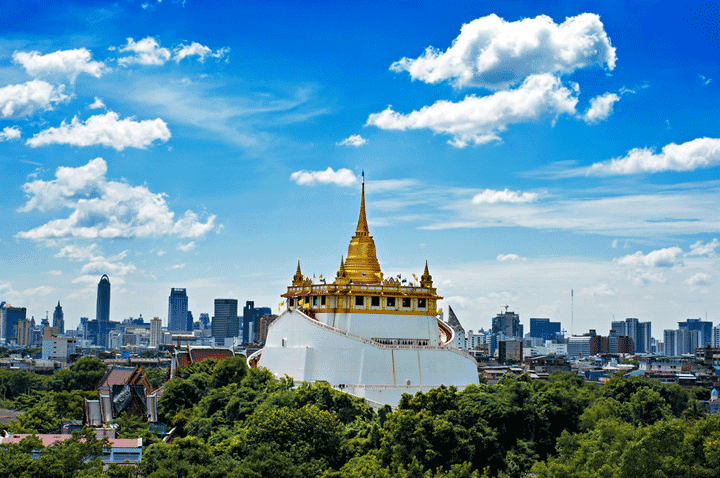
Wat Saket in Bangkok
Wat Saket or the Temple of the Golden Mount is a special temple in the heart of Bangkok and is located on it to dolist of most tourists. And this is only right. Because this colorful monastery complex, which was built in the last half of the 18e century, not only exudes a very special atmosphere, but also rewards the persevering among the pilgrims and visitors on smog-free days, after the climb to the top, with a - for some breathtaking - panorama over the metropolis.
The Golden Mountain is centrally located on the grounds of Wat Saket. The core of this so-called mountain is formed by the ruins of a large chedi that was built here by Rama III. This chedi did not last long because it collapsed almost immediately after construction because the very swampy ground could not support its enormous weight. Decades of neglect caused the ruin to become overgrown and gradually take on the appearance of a mountain. Under the reign of Rama V, with the help of some bricks and a lot of cement, this site was effectively transformed into a real, albeit artificial, mountain. In those days, when Bangkok was still spared from skyscrapers competing in tastelessness and height, it was also the highest point in the city.
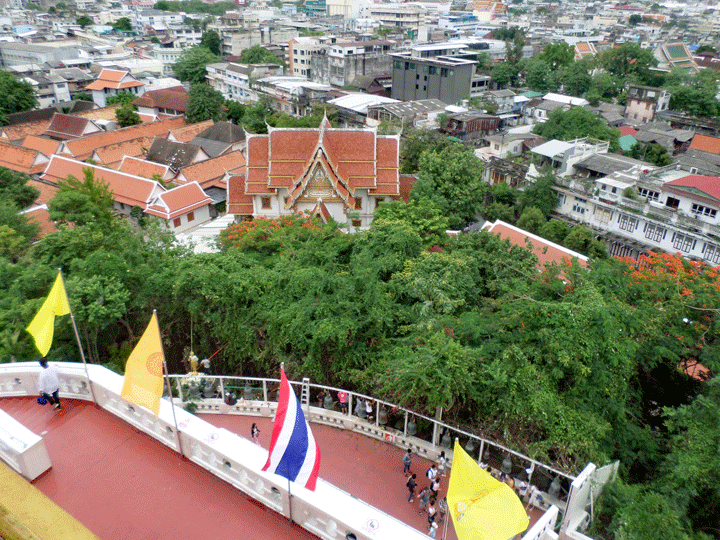
On top of the Golden mountain
A persistent rumor has it that during the construction of the Golden Mountain, a relic of Buddha would have been stored, which Rama V had received as a gift from the Viceroy of India during a state visit. Whether this is the case I leave in the middle, but it is an established fact that the mountainside was used as a cemetery for decades - mainly by wealthy Thai-Chinese families. The wide staircase, richly smeared with oxblood red concrete paint, leads visitors not only to the shrine and chedi at the top, but also past these tombs, bronze monastery bells, a mega-sized gong and a bizarre collection of sometimes very kitschy and strange-looking statues.
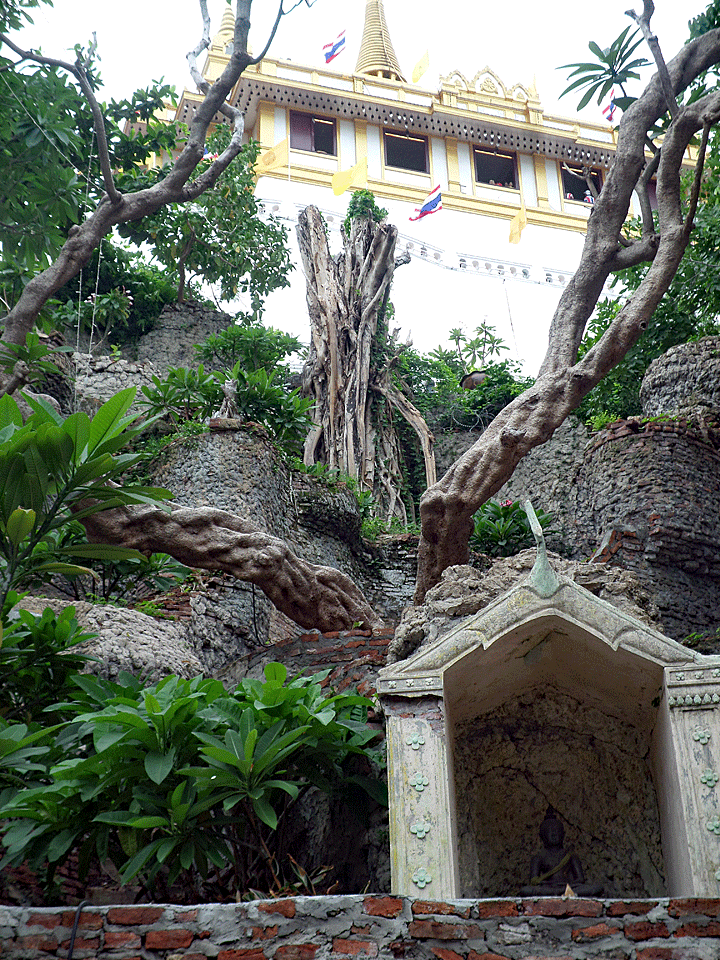
Graves Golden mountain
When descending from the Gouden Berg, visitors are confronted with an unexpected spectacle: a sinister group of sculptures that seem to have escaped from the Spookslot of De Efteling. Leaning against the vine-covered rock wall, among the scattered human bones, is a rotting corpse on which a bunch of vultures feast. This very realistically executed, life-sized and very lurid scene, including loosely hanging intestines, is observed by a number of Siamese, who according to their outfit belong in the nineteenth century. This scene refers to one of the darkest periods in the existence of this monastery and the city.
In 1820, under the reign of Rama II (1809-1824), Bangkok was ravaged shortly after the rainy season by a cholera epidemic that wreaked havoc among the capital's population. The City of Angels was transformed into the City of Death in just a few weeks. According to historical sources, the disease would have spread rapidly from the Malaysian island of Penang - then a vassal state of Siam - across town and country. In reality, it was perhaps the poor and unhygienic living conditions in combination with contaminated drinking water that took their toll. According to the chronicles, more than 30.000 people were killed in Bangkok alone. Accounting for almost a quarter of the then population.
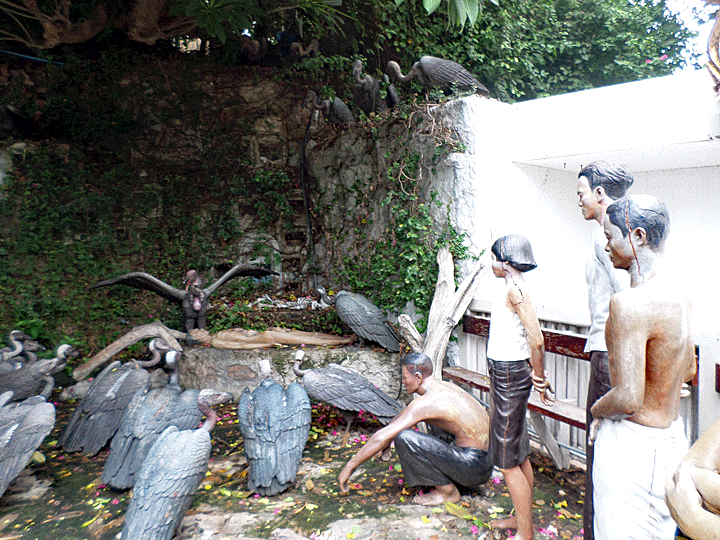
Vultures Wat Saket
In that period it was not customary to cremate the dead within the city walls. For hygienic reasons, it was only allowed to bring the corpses out through only one city gate. This gate was located near Wat Saket and during the epidemic it was not long before the corpses of the victims piled up in and around the monastery awaiting cremation or burial. This large concentration of carcasses inevitably attracted vultures and other scavengers and it really didn't take long for them to become a familiar sight at the temple.
All the more so because Bangkok would be hit regularly by cholera in the next six decades. The worst outbreak probably took place in 1849 when cholera and possibly also typhus affected an estimated one twentieth of the Siamese population... Hundreds of corpses were brought to Wat Saket every day during that dark period. They piled up so high in the courtyard that volunteers would chop them up, as was done for centuries in Tibet, for example, and feed them to the carrion animals outside the temple walls. The eaten bones were then cremated and buried.
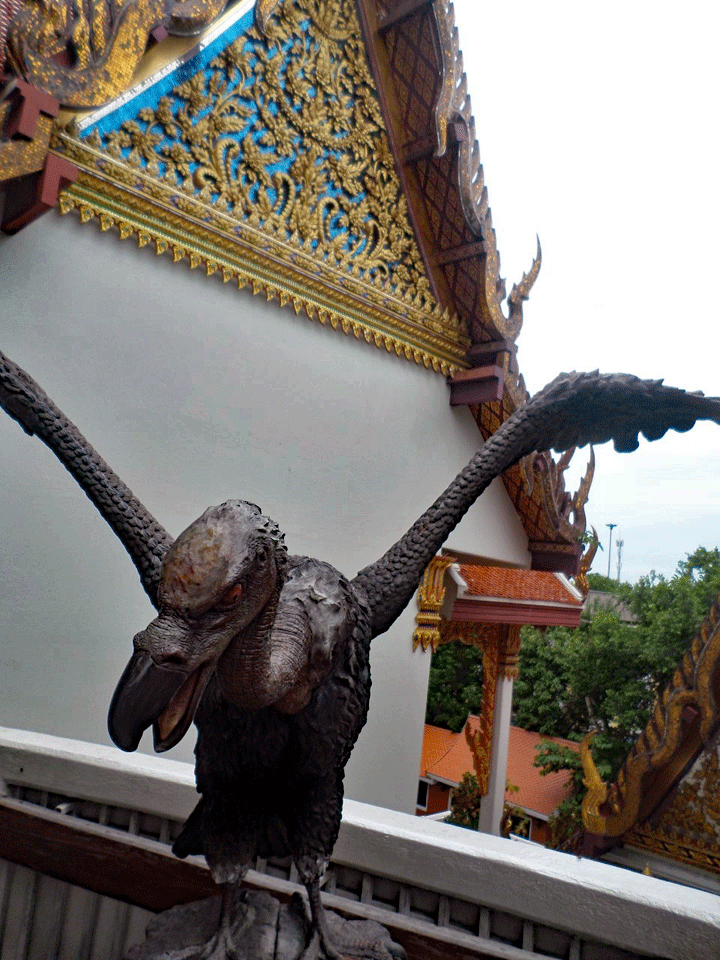
Wat Saket
The hungry vultures not only crowded the trees around the temple, but also crowded the roofs of the monastery and fought frenetically for the best morsel above the rapidly decomposing carcasses in the heat. The enormous piles of rotting and fermenting corpses with the sinister dense swarms of vultures hovering above them formed a gruesome spectacle that illustrated the transience of human existence like no other and for that very reason exerted a great attraction on monks who, meditating in the smoke of the nearby funeral pyres , frequented this site of death and decay for this reason. Somdej Phra Phuttachan (Toh Brahamarangsi), the tutor of King Mongkut, revered to this day, was undoubtedly the most important of these remarkable pilgrims to Death.
Only under the reign of Rama V (1868-1910) when people in Bangkok, partly influenced by Western ideas, started to deal with public drinking water supply and sewerage works, did this plague come to an end.
If a guide tells you when you visit this unique and historically charged site that some Thai people are convinced that this temple is haunted, you will immediately know why…


Another nice story. Lung Jan. I also wrote about it, see the link below.
Feeding a corpse to vultures and other beasts has little to do with epidemics: it has been happening for centuries. It has to do with the Buddhist view of good deeds: generosity in this case. Offering your corpse to the animals gives more merit and better karma. That's why it was done.
https://www.thailandblog.nl/boeddhisme/vrijgevigheid-oude-crematie-rituelen-saket/
Deceased poor and prisoners were also thrown to the vultures in Wat Saket / Wat Sa Kate. Anyone who has the book “Siam on the Meinam, from the Gulf to Ayuthia, Maxwell Sommerville” from 1897 will find an unsavory description of the bloody scene that was performed there by vultures and dogs.
“when Bangkok was spared from skyscrapers competing in tastelessness and height”.
As an architect, I disagree with this statement. I think the skyscrapers are BKK unique and good architecture. We don't stay in the Middle Ages with our thoughts, do we?
Dear Carlo,
Do you find that really unique as an architect?
So monotonous and impersonal. Give me the beautiful skyscrapers of Dubai, for example, with their original heights, and their beautiful architectural finds.
Very worth knowing. Thank you. HG